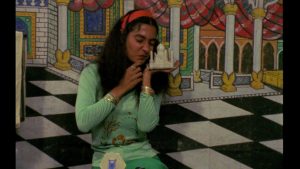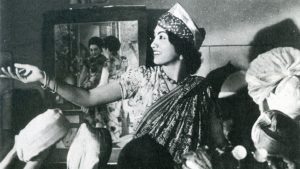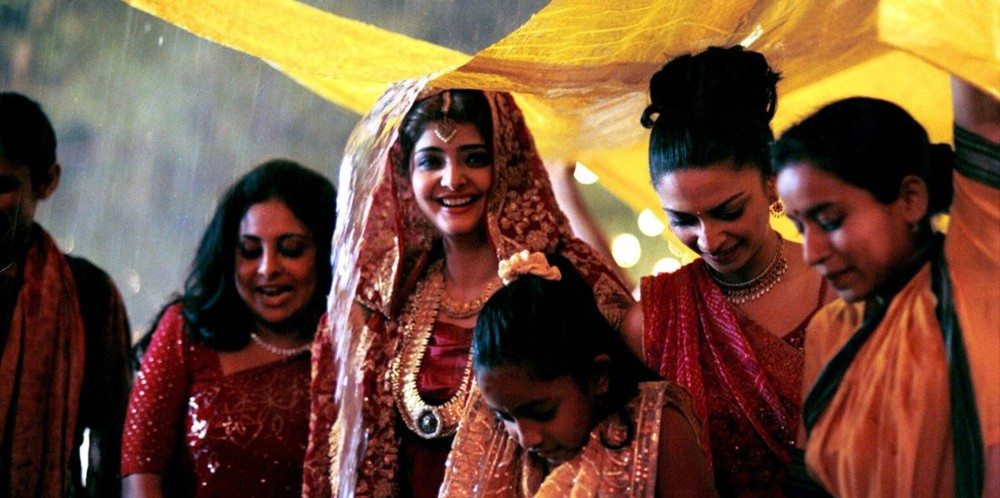5. Om-Dar-B-Dar (1988)

If you have seen or even heard about this eccentric, postmodern moodpiece from the eighties, I tip my hat at you. ‘Om Dar-B-Dar’, at the core, chronicles the coming-of-age of a boy named Om in Rajasthan. The film employs a non-linear narrative and an absurdist storyline in an attempt to satirise art, politics, philosophy and mythology. Even the film’s songs are sporadic, choppy and illogical, and are used tongue-in-cheek to mock the tradition of spontaneous songs and musical numbers in Bollywood cinema. The film, although made in 1988, was never commercially released in India until 2014! If that isn’t an “ahead of its time” stamp, I don’t know what is!
4. No Smoking (2007)

The year was 2007. Akshay Kumar was ruling the box office with his slapstick comedies like ‘Singh Is Kinng’. Formulaic cinema was working wonders. That’s when India’s resident maverick Anurag Kashyap dared to release ‘No Smoking’, a surrealistic neo-noir psychological thriller based on a Stephen King short story named ‘Quitters Inc.’. Kashyap managed to give the story an Indian spin and created a genuinely baffling film. But while it received accolades overseas, neither critics nor audiences back home warmed up to it, which is a travesty. It is a divisive film, hailed by some as a Lynchian masterpiece and has garnered a niche fandom who marvel at its cryptic nature. while others bash it for making no sensible connection between its sequences and only existing to baffle its viewers. It is a film so bizarre I wrote a whole piece explaining its varied interpretations and symbolism, and a film so ahead of its time I’m not even sure when our country will reach a level of cinematic connaissance to appreciate it.
3. The Elements Trilogy (1996-2005)

Deepak Mehta’s Elements Trilogy is an Indo-Canadian production of a troika of films – Fire, Earth and Water. These films deal with controversial issues of socio-economic reform on the Indian subcontinent. ‘Fire’ (1996) deals with arranged marriage and homosexuality in the midst of India’s patriarchal culture. ‘Earth’ (1998), deals with the religious strife caused due to the partition of India. Whereas ‘Water’ (2005) comments on the Sati custom, child marriage and misogyny through the lives of widows in 1930s India. All three films have been critically acclaimed for their unbridled, raw and honest portrayal of India’s social canvas. But the films never garnered the audience attention they deserved despite presence of some famed stalwarts like Seema Biswa. Shabana Azmi and Aamir Khan in their rosters. Here’s hoping this piece, in however small a way, changes that.
2. Mera Naam Joker (1970)

The year was 1970. It had been six years since Raj Kapoor had released the musical blockbuster ‘Sangam’. His next film, which was also going to his son Rishi, was thus highly anticipated. But when it released, ‘Mera Naam Joker’ was panned by critics and blown off by audiences for its unconventional length of nearly five hours (featuring two intervals) and experimental plot, which is said to have been an allegory of Kapoor’s own life. The film shattered convention on multiple fronts, by displaying nudity and even showing a schoolteacher as the focus of a student’s infatuation. Consequently, it failed so miserably that it almost drove Kapoor to sell his famed RK Studios. But the film has gained favour from both over the years and is now hailed as a ‘misunderstood masterpiece’. An abridged version of the film was released in the 80s and had a highly successful run at the box office. Now ‘Mera Naam Joker’ is a cult classic and considered one of the showman’s finest works. Sweet justice indeed.
1. V. Shantaram’s Reformist Trilogy (1937-1941)

To call V. Shataram a pioneer of Indian cinema would be an understatement. He has a plethora of Indian film firsts in his name – first children’s film (‘Ranisahiba’, 1930), first use of the trolley (‘Chandrasena’, 1931), first use of the telephoto lens (‘Amrit Manthan’, 1934) and first use of animation (‘Jambukaka’, 1935) – to name a few. But it is his trilogy of bilingual socially reformist films at Prabhat studio which truly make him one of India’s most progressive film figures.
‘Duniya Na Maane’ (‘Kunku’ in Marathi) is a daring, stark commentary on the treatment of women in Indian society. ‘Aadmi’ (‘Manoos’ in Marathi) is based on a short story called ‘The Police Constable’ and revolves around the love of a policeman for a prostitute and his attempts to rehabilitate her, which draw ire from the conceited society. ‘Padosi’ (‘Shejari’ in Marathi) is a film made against the backdrop of the communal tension which resulted from the formation of the Muslim league and promotes Hindu-Muslim brotherhood (in an era in which Pakistan hadn’t even come to existence!) Not only were his troika of films ahead of their time in their core message, they were ahead in their technique as well (instances being the use of shadows for depicting mood in ‘Aadmi’ and Mazhar Khan, a Muslim playing the role of a Hindu and Gajanan Jagirdar, a Hindu play the Muslim character in ‘Padosi’). Shantaram’s trilogy of socially cognizant films is thus, some of the most visionary filmmaking our country has seen.
Read More: Best Adult Bollywood Movies


You must be logged in to post a comment.